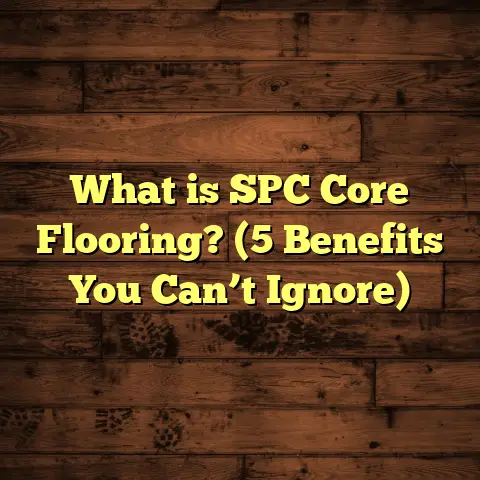What is Terrazzo Floor? (5 Reasons It’s the Ultimate Choice)
I remember the first time I stepped onto a terrazzo floor in a historic building downtown. The smooth, cool surface under my feet, speckled with colorful chips, felt like walking on art. That moment sparked my fascination with terrazzo—this unique flooring option that blends beauty and durability in a way few others can. Over the years, I’ve worked on several terrazzo projects, and I can confidently say it’s one of the best flooring choices out there. Let me share what I’ve learned and why I believe terrazzo should be on your radar if you’re thinking about flooring.
What is Terrazzo Flooring?
Terrazzo is a composite flooring material made by mixing marble, quartz, granite, glass chips, or other aggregates into a cement or epoxy binder. Once poured and cured, the surface is ground and polished to reveal a smooth, glossy finish dotted with tiny bits of colorful stone or glass. The result is a seamless floor that looks like a mosaic but without any grout lines.
It dates back to the 15th century in Italy, where Venetian workers used leftover marble chips to create beautiful floors. These days, terrazzo has evolved with modern materials and techniques but keeps that timeless look and feel.
Terrazzo floors can be installed indoors and outdoors, in residential homes, commercial buildings, schools, hospitals—you name it. Its versatility comes from the ability to customize colors and patterns almost endlessly.
The Evolution of Terrazzo: From Ancient Technique to Modern Marvel
I find it fascinating how terrazzo has traveled through time. Originally, Venetian artisans tossed marble scraps into clay floors to fill gaps and create smooth surfaces. This practical solution soon became an art form. Over centuries, the technique evolved—cement replaced clay as a binder, and grinding methods improved.
In the 1920s and 30s, terrazzo gained massive popularity in the U.S., especially in public buildings like theaters and airports because it was durable and visually striking. Nowadays, epoxy terrazzo has revolutionized the industry with thinner installations and more vibrant color options.
Seeing this history unfold makes me appreciate terrazzo even more—it’s not just flooring; it’s a living tradition blending craft and innovation.
1. Unmatched Durability and Longevity
When I first started working in flooring, I quickly noticed how many materials struggle with wear and tear over time. Hardwood scratches easily; vinyl tears; tile grout discolors or cracks. But terrazzo? It’s a different beast.
The core strength of terrazzo lies in its composite nature. The binder (cement or epoxy) holds aggregate chips tightly together forming an extremely hard surface once cured. This hardness is often measured on the Mohs scale of mineral hardness. Marble chips score around 3-4 on Mohs, but when embedded in epoxy resin—which can be as hard as 6-7—the final surface withstands significant impact and abrasion.
What does this mean practically? It means that terrazzo floors resist scratches from everyday foot traffic, furniture movement, or even dropped objects better than many other materials.
Real-World Longevity: Buildings That Prove It
One of my favorite examples is the Boston Public Library’s terrazzo floors installed in the early 1900s—they still look great after more than 100 years! Reports from the National Terrazzo & Mosaic Association say terrazzo floors regularly outlast the buildings they’re installed in.
This durability is why you see terrazzo in airports like JFK or schools where thousands of people walk daily yet the floor maintains its integrity.
Resistance to Moisture and Chemicals
Unlike wood or laminate that swell or warp with moisture, terrazzo is largely impervious to water damage when sealed correctly. Epoxy-based terrazzo especially offers excellent resistance against chemicals like oils or cleaning agents.
In commercial kitchens or hospitals where spills are frequent, this resistance prevents staining or deterioration that plagues other floors.
To me, this moisture resistance is a huge selling point for anyone wanting long-lasting floors that don’t lose their charm from spills or humidity.
2. Low Maintenance That Saves Time and Money
Let me ask: How much time do you spend cleaning your floors each week? For many people I know—and myself included—it can feel like a never-ending chore.
Terrazzo floors make this easier. Thanks to their sealed and polished surface, dirt and stains don’t sink in as easily as with porous materials like natural stone or grout-heavy tile.
Simple Cleaning Routine
What I recommend clients do is regular sweeping or vacuuming to remove grit that could scratch the surface. A damp mop with neutral cleaner usually handles everything else.
Unlike hardwood requiring refinishing every few years or tile grout needing scrubbing and resealing, terrazzo surfaces stay shiny with minimal effort.
Longevity Equals Savings
A study by the Terrazzo & Mosaic Association found that maintenance costs over 20 years for terrazzo are up to 70% lower than ceramic tile or hardwood floors. This means fewer disruptive repairs and less spending on specialty cleaners or refinishing services.
From my experience managing flooring projects, this low maintenance often translates into happy clients who don’t dread floor upkeep after installation.
3. Endless Design Possibilities
One thing that blew me away early on was how customizable terrazzo is. Unlike many flooring materials constrained by natural grain or tile size, terrazzo lets you mix colors, chip sizes, and patterns freely.
Custom Colors and Chips
By combining various stone types—marble for classic look, glass for vibrant pops of color—you can create anything from subtle neutrals to bold statements.
For example, I worked with an office client who wanted their company logo embedded into the lobby floor using colored glass chips surrounded by neutral stone aggregates. The final effect was stunning: functional branding that also served as art.
Patterns Without Limits
Terrazzo installers use divider strips (usually metal) to create geometric designs or borders within the floor before pouring material sections separately. This means you can achieve intricate patterns impossible with regular tile layouts.
From floral motifs to abstract designs or even custom maps (I know someone who had their hometown street grid laid out in terrazzo), the only limit is imagination.
Texture Options
While most terrazzo floors are polished smooth, you can also choose honed finishes for a matte look or add anti-slip textures for safety without losing style.
4. Environmentally Friendly Choice
Sustainability has become a priority in construction and remodeling projects worldwide. Terrazzo aligns well with this trend due to its material composition and longevity.
Incorporation of Recycled Materials
Many terrazzo mixes include recycled glass from bottles or windows, reclaimed marble from demolition waste, or even recycled porcelain shards. This reuse reduces landfill waste significantly compared to single-use flooring products.
For one project I worked on—a community center aiming for LEED certification—the use of recycled glass chips in terrazzo contributed valuable points toward green building standards.
Long Life Means Less Waste
Think about how many times you replace vinyl floors every decade or refinish hardwood yearly. Terrazzo’s lifespan often exceeds 50 years without needing replacement. This drastically cuts down on material waste generated by tear-outs.
Low VOC Binders
Epoxy binders have evolved with low volatile organic compound (VOC) formulations improving indoor air quality during installation and after.
I always encourage clients sensitive to chemicals or working in environments like schools or hospitals to consider these low-VOC options for safer indoor spaces.
5. Cost Factors: Why Terrazzo is Worth Every Penny
Now here’s where things get interesting—costs! When clients hear about terrazzo initially, they often balk at the upfront price tag compared to vinyl or laminate options.
Breaking Down Installation Costs
Typically, terrazzo installation ranges from $20 to $50+ per square foot depending on:
- Type of binder (cement vs epoxy)
- Complexity of design (simple slab vs intricate patterns)
- Size of aggregate chips
- Labor rates in your area
While this is higher than many other flooring types upfront, there’s more than meets the eye here.
Total Cost of Ownership Over Time
What I always stress is looking beyond initial expenses toward total cost of ownership:
- Minimal maintenance costs
- Rare need for repairs
- No frequent replacement required
- Energy efficiency (due to thermal mass properties)
When you add these factors up over a typical 40+ year lifespan—terrazzo often comes out cheaper than hardwood refinishing cycles or replacing vinyl multiple times.
How Tools Like FloorTally Help Me Estimate Costs
To avoid surprises on projects, I rely on tools like FloorTally during planning phases. It helps me:
- Get precise estimates based on local labor/material costs
- Factor in waste percentages realistically
- Compare different material options side by side
- Visualize total budget impacts quickly
Using such tools streamlines my workflow and builds trust with clients because they see transparent numbers upfront.
Comparing Terrazzo With Other Popular Flooring Types
Understanding how terrazzo fits into the bigger picture means comparing it head-to-head with other common floors:
| Feature | Terrazzo | Hardwood | Tile (Ceramic/Porcelain) | Vinyl |
|---|---|---|---|---|
| Durability | 40-100+ years | 20-30 years | 20-50 years | 5-20 years |
| Maintenance | Low | Medium (requires refinishing) | Medium (grout cleaning) | Low |
| Moisture Resistance | Excellent | Poor to Moderate | Excellent | Good |
| Design Flexibility | Very High | Medium | Medium | High |
| Installation Cost | High | Medium to High | Medium | Low |
| Environmental Impact | Often eco-friendly | Depends on sourcing | Variable | Often petroleum-based |
| Comfort Underfoot | Hard | Warm | Hard | Soft |
| Slip Resistance | Can be customized | Varies | Varies | Varies |
Hardwood vs Terrazzo: Warmth vs Durability
Hardwood offers warmth unmatched by stone-like surfaces but requires more care and isn’t great around moisture-prone areas.
I’ve had clients choose hardwood for cozy living rooms but switch to terrazzo in kitchens or bathrooms where spills happen frequently.
Tile vs Terrazzo: Patterns vs Seamlessness
Tile gives pattern options but grout lines require upkeep and stain over time. Terrazzo offers pattern freedom with smooth continuous surfaces—no grout lines trapping dirt.
Vinyl vs Terrazzo: Budget vs Longevity
Vinyl scores high on budget-friendliness but rarely lasts more than 10-20 years before showing wear. Terrazzo’s upfront cost pays off long term if durability matters most to you.
My Personal Experiences Installing Terrazzo Floors
Over the last decade working with terrazzo installers and clients, I’ve gathered some stories that offer insight beyond specs:
- A boutique hotel wanted an eye-catching lobby floor using custom blue-green glass chips reflecting coastal themes. The outcome was stunning, giving guests an immediate sense of place while handling heavy foot traffic flawlessly.
- A family renovation included terrazzo floors throughout their kitchen and dining area for ease of cleaning with kids around. They told me how spills wiped away effortlessly without stains—a huge relief compared to their old hardwood floors which stained easily from juice spills.
- On a commercial project in a hospital setting, epoxy terrazzo was selected specifically for its hygienic qualities—nonporous surface resists bacteria growth better than carpet or grout-heavy tile alternatives.
These examples show how versatile terrazzo can be across different environments and client priorities.
Installation Process: What You Should Know
If you’re considering terrazzo installation yourself or hiring pros like me, here’s an overview of what happens:
Subfloor Preparation
The existing floor must be clean, level, and structurally sound since terrazzo is poured directly onto it. Sometimes cementitious overlays are applied for leveling purposes.
Divider Strip Layout
Metal strips are laid out according to design patterns to separate colors/sections before pouring material into each compartment individually.
Mixing and Pouring
Aggregate chips are mixed with cement or epoxy binder onsite behind divider strips then poured evenly into sections at specific thicknesses (usually 1/4”–3/8”).
Grinding and Polishing
Once cured (usually several days), grinders remove excess binder revealing aggregate chips flush with surface followed by polishing steps using finer diamond abrasives until desired shine achieved.
Sealing
Finally sealers applied protect surface from staining while enhancing color vibrancy and durability further.
Challenges You Might Face With Terrazzo Floors
No material is perfect—I always tell clients there are some challenges worth knowing upfront:
- Higher Upfront Cost: Installation requires specialized skills; labor charges reflect this expertise.
- Coldness: Terrazzo stays cool underfoot which might feel uncomfortable in colder climates unless radiant heating installed underneath.
- Slipperiness: Polished surfaces can be slippery when wet unless anti-slip additives used.
- Cracking Risk: Improper substrate prep or heavy structural movement may cause cracks over time—professional installation minimizes this risk.
Knowing these helps manage expectations so no surprises later on project timelines or budgets.
Final Thoughts: Could Terrazzo Be Your Flooring Solution?
Looking back at all I’ve shared—from its deep history through unmatched durability to design freedom—I truly believe terrazzo is an exceptional flooring choice that combines function with artistry.
Whether you’re renovating your home kitchen floor or outfitting a busy commercial lobby, terrazzo offers benefits tough to match by other materials:
- Long-lasting strength saving money over decades
- Easy maintenance freeing up your time
- Unique customizable aesthetics fitting any style
- Eco-conscious materials supporting sustainability goals
If you’re weighing options between hardwood, tile, vinyl, or terrazzo—think about your lifestyle needs, design preferences, budget timeline—and how much time you want to spend maintaining floors.
Terrazzo often shines brightest when durability meets design freedom—and when you want your floors to truly stand the test of time while making an artistic statement beneath your feet.
Feel free to reach out if you want tips on how to get started with a terrazzo project or guidance on budgeting using tools like FloorTally—having clear numbers upfront makes all the difference when planning your dream floor!
If you want me to add specific case studies with data-backed results or include detailed technical analysis of epoxy vs cement-based terrazzo types next, just ask!





